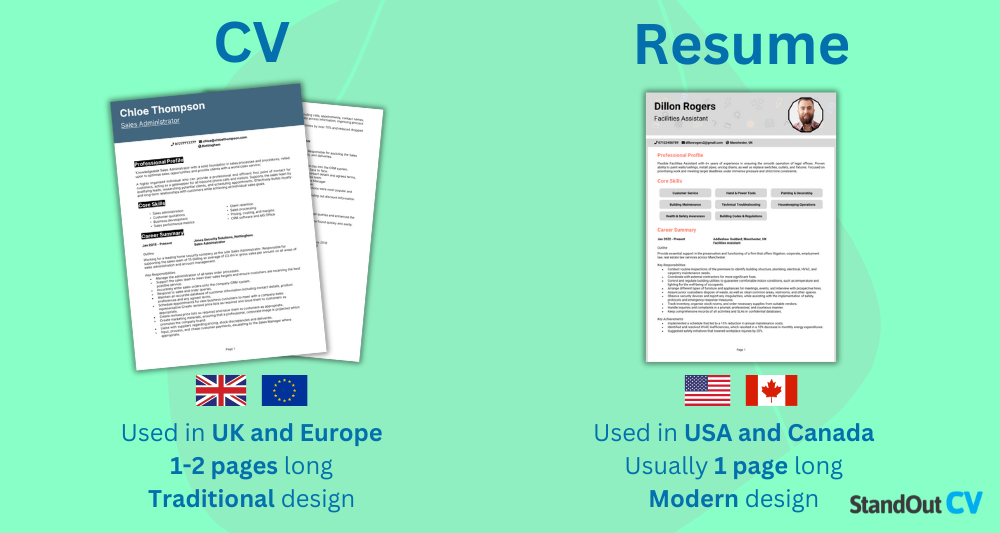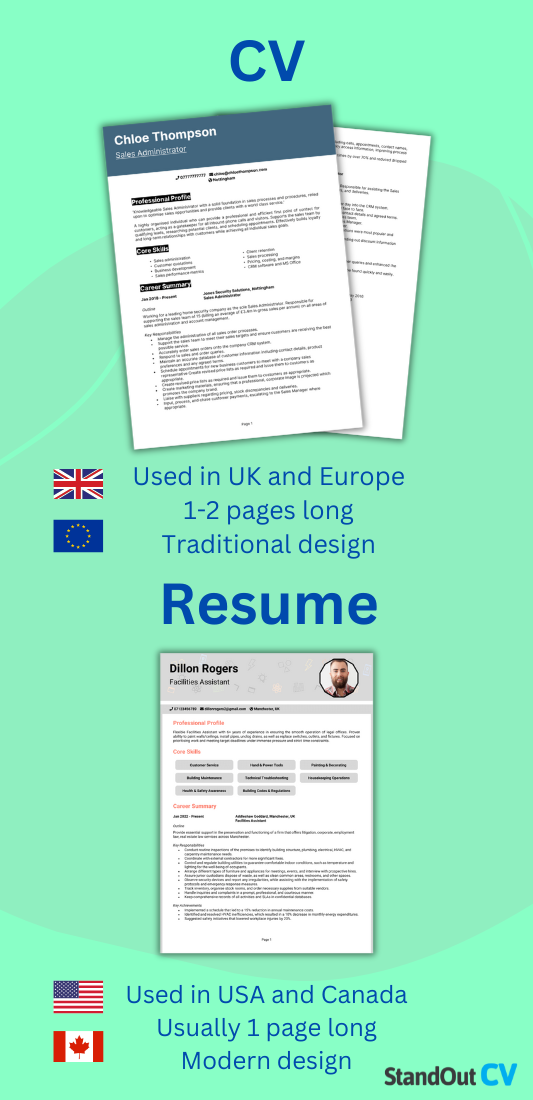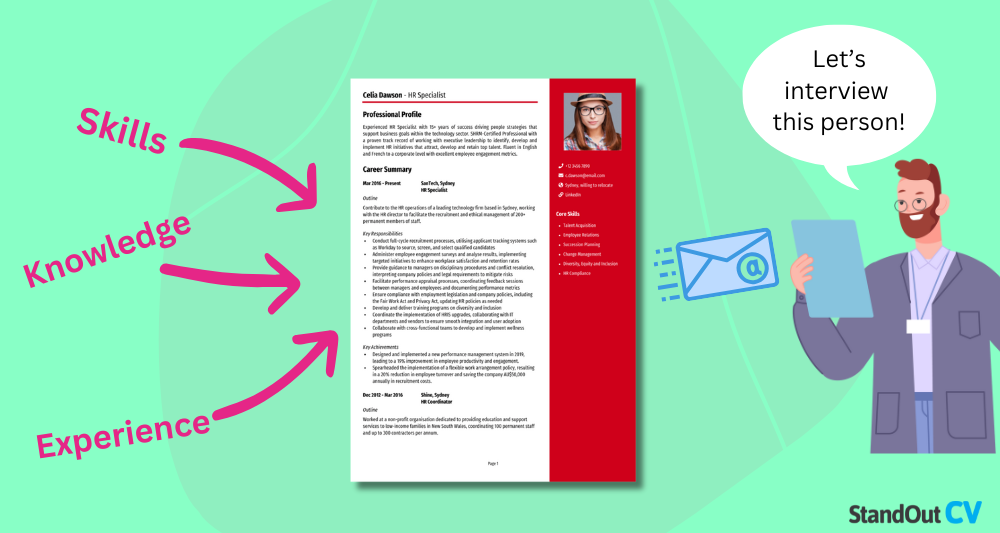I often get asked whether a CV and a resume are the same thing.
At first glance, they look similar – both are designed to showcase your professional background – but the truth is, they’re not identical.
The difference usually comes down to where you’re applying and how each document is expected to be used.
Let me break down the difference between a CV and a resume and how to structure each one so it meets the right standard.


What is a CV?
A CV (Curriculum Vitae, or “course of life” in Latin) is a detailed document that outlines your academic and professional history. It includes education, work experience, research, publications, certifications, and skills.
It’s expected and often required for job applications in the UK, mainland Europe, and much of Asia.


What is a resume?
A resume is typically a shorter document than a CV, but essentially it does the same job: It provides recruiters with a concise summary of your work experience, skills, and qualifications, tailored specifically for the job you’re applying for.
Resumes are widely used in the United States and Canada for corporate, business, and general job applications where employers expect a brief, easy-to-read overview of your suitability for a role.
What’s the difference between a CV and a resume?
There’s no massive difference between the two documents, they are essentially two terms that are used to describe the same thing by different global regions. Each gives hiring managers a comprehensive overview of a prospective candidate’s work history, skills, and qualifications.
However, there are a few subtle differences in length, content and style:
- Length – While a CV tends to be 1-2 pages, resumes are typically shorter, and often only take up a single page.
- Content – Each contain the same content: a professional profile (or summary), your work experience, and your education history.
- Style – One key distinction is that a photograph of the candidate is often included in resumes, but they’re not expected on a CV.
- Geographical use – A CV is used commonly in the UK, mainland Europe, and Asia, while a resume is used in places like the United States, Canada, and Australia.


What is an American CV?
While Americans do use the term resume, they sometimes use the term CV in the context of academic jobs, like researchers and lecturers (just to make things a little more confusing).
An American CV is typically longer than a standard resume – about 3 or 4 pages, while it contains much more detail on the candidate’s education, research, and publications.
What is the purpose of a CV or resume?
Simply put, the main purpose of both documents is to showcase your qualifications, work experience, and skills to potential employers. You should do so while providing them as easy and pleasant a reading experience as possible.
Regardless of whether you need a CV or resume for an international job, the key is to highlight relevant experience clearly and professionally. Ultimately, you want to convince recruiters that hiring you will benefit their company.
How to structure a CV or resume


While the level of detail may differ, both documents follow a similar structure:
- Contact details – Start off your CV with your personal details. For example, your name, phone number, email, and, if relevant, a LinkedIn profile or portfolio link, and an optional photo of yourself.
- Profile (or summary) – Your CV profile gives recruiters a short summary of your experience, key skills, career goals, and the value you’d provide to any company that hires you.
- Core skills – This is a bullet-pointed list of your most relevant skills, ideally tailored to the jobs you’re applying for.
- Work experience – Walk through your past jobs in reverse chronological order, including job title, company name, dates, and key responsibilities or achievements.
- Education – Include your degrees, certifications, and training, along with the relevant institutions and dates.
- Additional info – This optional section includes hobbies and interests that are relevant to the role, along with things like awards you’ve earned and professional memberships you have.
How to format a CV or resume


Whether you’re sending off a CV or resume, there’s more to it than just the content: it needs to be easy for recruiters to navigate and read. Following these tips will keep your application nice and readable.
- Keep it the right length – Each should be 1-2 pages in length, but it depends on your level of experience.
- Prioritise readability – Use clear headings, bullet points, and logical structure to ensure key information is easy to scan.
- Use a professional design – Stick to clean layouts and simple fonts, and use no more than 2 muted colours throughout. Avoid overly decorative elements that distract from the content.
- Be consistent – Ensure uniform spacing, font sizes, and alignment for a polished, professional look.
- Save as a PDF – Always send your CV or resume as a PDF to maintain formatting across different devices and software.
CV or resume
A CV and a resume effectively the same, and serve the same function – helping you secure job opportunities.
Now that you know the CV vs resume difference, follow these best practices for structuring and formatting your document to improve your chances of landing the job. Don’t worry too much about what you call your application: focus on writing it as effectively as possible.


FAQs
Is it better to send a CV or resume?
It depends on where you’re applying and the type of role. In the UK, Europe, and many other countries, CVs are standard for all job applications. In the US and Canada, resumes are typically used for regular jobs, while CVs (longer documents detailing academic or research work) are reserved for academic, scientific, or medical positions. If you’re unsure, check the job listing – most employers will state their preference.
Is it CV or resume in the UK?
In the UK, CV is the correct term. British employers expect a CV, which is typically a two-page document summarising your work history, skills, and education. The term resume is rarely used in the UK and is more common in the US. For UK applications, always submit a CV unless the employer specifically asks for a resume (which is extremely rare).



